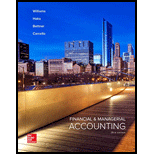
Identify the purpose of
Answer to Problem 1STQ
Option (c) is the correct answer.
Apply the realization principle and the matching principle to transactions affecting two or more accounting periods.
Explanation of Solution
Option (a) Adjust the
Option (b) Adjust daily the balances in asset, liability, revenue, and expense accounts for the effects of business transaction is not the purpose of adjusting entries. Thus, option (b) is not the correct answer.
Option (c) Apply the realization principle and the matching principle to transactions affecting two or more accounting period is the purpose of adjusting entries. Thus, option (c) is the correct answer.
Option (d) Prepare revenue and expense accounts for recording the transactions of the next accounting period is not the purpose of the adjusting entries. Thus, option (d) is not the correct answer.
Thus, as per the above explanation option (a), (b), and (d) are the wrong answers. Hence, Option (c) is the correct answer.
Thus, Option (c) is the correct answer.
Apply the realization principle and the matching principle to transactions affecting two or more accounting periods.
Want to see more full solutions like this?
Chapter 4 Solutions
Financial & Managerial Accounting
- Which accounting principle requires that expenses be recorded in the same period as the revenues they help generate?A. Cost PrincipleB. Revenue Recognition PrincipleC. Matching PrincipleD. Full Disclosure Principlearrow_forwardI need guidance with this financial accounting problem using the right financial principles.arrow_forwardWhat is the formula for calculating the weighted average cost of capital (WACC)?A) WACC = (Cost of Debt × Proportion of Debt) + (Cost of Equity × Proportion of Equity)B) WACC = (Cost of Debt + Cost of Equity) / 2C) WACC = Cost of Debt + Cost of EquityD) WACC = Proportion of Debt + Proportion of Equityarrow_forward
- If a company has annual sales of $840,000 with a gross profit margin of 35%, what is the cost of goods sold?arrow_forwardKindly help me with general accounting questionarrow_forwardA business purchased a machine for $120,000 with an estimated useful life of 8 years and salvage value of $24,000. What is the annual straight-line depreciation amount? Helparrow_forward
- Windsor Manufacturing had budgeted overhead costs of $420,000 for the year. The company applied $420,000 of overhead, but the actual overhead incurred amounted to $435,000. Based on this information, what are the fixed overhead price variance for Windsor Manufacturing?arrow_forwardFinancial Accounting Questionarrow_forwardPlease provide the answer to this general accounting question using the right approach.arrow_forward

 AccountingAccountingISBN:9781337272094Author:WARREN, Carl S., Reeve, James M., Duchac, Jonathan E.Publisher:Cengage Learning,
AccountingAccountingISBN:9781337272094Author:WARREN, Carl S., Reeve, James M., Duchac, Jonathan E.Publisher:Cengage Learning, Accounting Information SystemsAccountingISBN:9781337619202Author:Hall, James A.Publisher:Cengage Learning,
Accounting Information SystemsAccountingISBN:9781337619202Author:Hall, James A.Publisher:Cengage Learning, Horngren's Cost Accounting: A Managerial Emphasis...AccountingISBN:9780134475585Author:Srikant M. Datar, Madhav V. RajanPublisher:PEARSON
Horngren's Cost Accounting: A Managerial Emphasis...AccountingISBN:9780134475585Author:Srikant M. Datar, Madhav V. RajanPublisher:PEARSON Intermediate AccountingAccountingISBN:9781259722660Author:J. David Spiceland, Mark W. Nelson, Wayne M ThomasPublisher:McGraw-Hill Education
Intermediate AccountingAccountingISBN:9781259722660Author:J. David Spiceland, Mark W. Nelson, Wayne M ThomasPublisher:McGraw-Hill Education Financial and Managerial AccountingAccountingISBN:9781259726705Author:John J Wild, Ken W. Shaw, Barbara Chiappetta Fundamental Accounting PrinciplesPublisher:McGraw-Hill Education
Financial and Managerial AccountingAccountingISBN:9781259726705Author:John J Wild, Ken W. Shaw, Barbara Chiappetta Fundamental Accounting PrinciplesPublisher:McGraw-Hill Education





